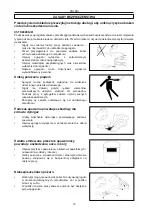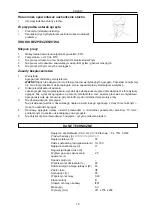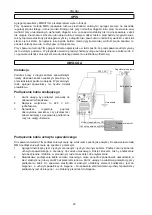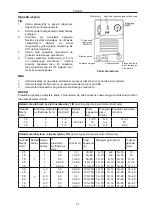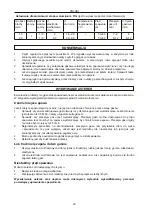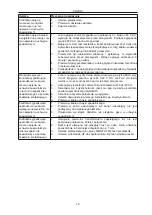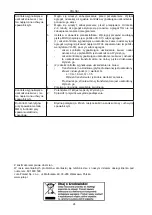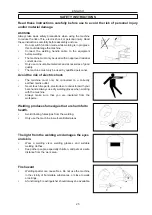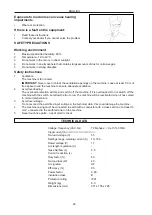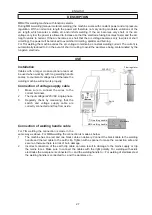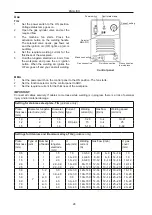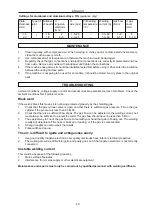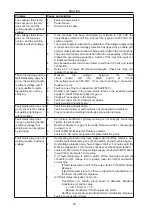
30
ENGLISH
Problem
Cause and solution
The voltage status lamp
does not go on, the fan
does not run, and the
welding handle is without
voltage.
1.
Fault on power switch.
2.
Power failure.
3.
Short circuit in cable.
The voltage status lamp
goes on, the fan does
not run, and the welding
handle is without voltage.
1.
If the machine has been connected by mistake to 380 VAC the
overvoltage protection will trip. Connect the machine to 230 VAC and
switch on again.
2.
The mains supply is unstable, the diameter of the voltage supply cable
is too small, or the overvoltage protection has tipped. Use a cable with
a larger cross sectional conductor area and/or tighten the connections.
3.
The power switch has been switched off and on repeatedly, which has
tripped the overvoltage protection. Switch off the machine, wait 2–3
minutes and switch on again.
4.
Gap between power switch and lower circuit board. Check and repair
connection.
5.
Relay 24 V on lower circuit board damaged. Check the relay and
replace if necessary.
The fan is running and the
fault status lamp does not
go on, the welding handle
is without voltage and it
is not possible to ignite
the welding arc even by
scraping.
1.
Measure the voltage between the lower
circuit
board
and
the
MOS
board
at
VH07.
The voltage must be 380 VDC. If not, short circuiting or connection
faults can occur.
2.
Fault on one of the four capacitors (470 µF/450 V).
3.
Contact your dealer if the green status lamp on the auxiliary power
supply for the MOS board goes not go on.
4.
Check all connections in the machine.
5.
Fault on control circuit. Contact your dealer.
6.
Fault in welding handle cable.
Fault status lamp does not
go on, there is HF voltage,
but welding handling is
without voltage.
1.
Fault in welding handle cable.
2.
Fault in earth cable, or earth cable is not connected to workpiece.
3.
Plus connection or welding handle gas connection is loose.
Fault status lamp does
not go on, welding handle
is without voltage, but
welding arc can be ignited
by scraping.
1.
Arc ignition transformer primary winding is not correctly connected.
Tighten the connection.
2.
Nozzle is oxidised, or gap is too wide. Remove oxide or change gap
to about 1 mm.
3.
Fault on MMA/TIG selector. Replace selector.
4.
Fault in HF circuit for arc ignition. Replace defective parts.
Fault status lamp goes on,
welding handle is without
voltage.
1.
Overheating protection may have tripped. Switch off the machine, wait
until the fault status lamp goes off, and switch on the machine again.
2.
Overvoltage protection may have tripped. Wait 2–3 minutes until the
machine reactivates. TIG unit does not have overheating protection.
3.
Fault in rectifier circuit. Pull out voltage supply conductor to MOS board
(near VH-07) and switch on machine.
•
(1) If fault status lamp is still on, switch off the machine and pull out
conductor for HF voltage for arc ignition (near fan VH-03) and swtich
on machine.
-
If fault status lamp is still on there is a fault on the MOS board.
Replace.
-
If fault status lamp is not on there is a fault on the transformer on
the lower circuit board. Replace.
•
(2) If fault status lamp does not go on.
-
Transformer on middle circuit board is defective. Measure
inductance (L) and Q-value
L = 0.9–1.6 mH, Q > 35.
Replace transformer if both values are small.
-
Rectifier on secondary side of transformer is defective. Replace.
4.
Fault in reconnection circuit.



